Chapter 11 - Money, Banking, and Monetary Policy
5.0(1)
5.0(1)
Card Sorting
1/62
Study Analytics
Name | Mastery | Learn | Test | Matching | Spaced |
|---|
No study sessions yet.
63 Terms
1
New cards
Stock
A certificate that represents a claim to, or share of the ownership of a firm
2
New cards
Equity financing
The firms method of raising funds for investment by issuing shares of stock to the public
3
New cards
Bond
A certificate of indebtedness from the issuer to the bondholder
4
New cards
Debt financing
A firms way of raising investment funds by issuing bonds to the public
5
New cards
Fiat money
The paper and coin money used today
6
New cards
Functions of money
* Medium of exchange
* Unit of account
* Store of value
* Unit of account
* Store of value
7
New cards
Medium of exchange
It follows the logic that your labor hours turn into money, the money turns into apples, the farmer then exchanges the money for an orchards apple crop, and so on
8
New cards
Unit of account
Units of currency measure the relative worth of goods and services
9
New cards
Store of value
Money is a relatively good way to store value, when theres no inflation, because it keeps its value
10
New cards
Money supply
The quantity of money in circulation as measured by the Federal Reserve (the Fed) as M1 and M2. It is assumed to be fixed at a given point in time.
11
New cards
Liquidity
A measure of how easily an asset can be converted to cash
12
New cards
M1
The most liquid of money definitions and the basis for all other more broadly defined measures of money
\
* M1 = Cash + Coins + Checking deposits + Traveler’s checks.
\
* M1 = Cash + Coins + Checking deposits + Traveler’s checks.
13
New cards
M2
It is less liquid than M1
\
* M2 = M1 + Savings deposits + Small time deposits + Money market deposits + Money market mutual funds.
\
* M2 = M1 + Savings deposits + Small time deposits + Money market deposits + Money market mutual funds.
14
New cards
Transaction demand
The amount of money held in order to make transactions. This is not related to the interest rate, but it increases as nominal GDP increases.
15
New cards
Asset demand
The amount of money demanded as an asset. As nominal interest rates rise, the opportunity cost of holding money begins to rise and you are more likely to lessen your asset demand for money.
16
New cards
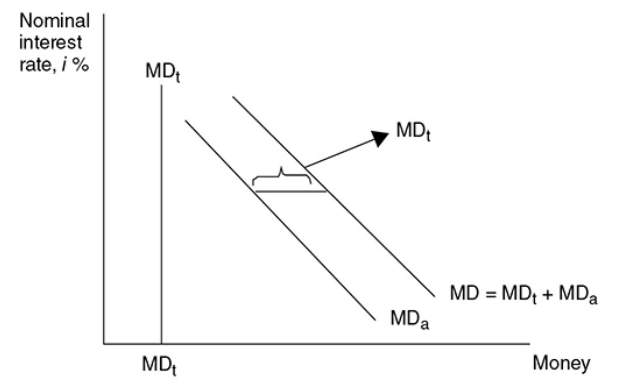
Total demand
Plotted against the nominal interest rate, the transaction demand for money is a constant MDt. Adding this constant needed to make transactions to a downward-sloping asset demand for money (MDa) creates the **total money demand curve.**
17
New cards
Money demand
The demand for money is the sum of money demanded for transactions and money demanded as an asset. It is inversely related to the nominal interest rate.
18
New cards
Theory of liquidity preference
Keynes theory that says that the equilibrium price of money is the interest rate where money supply intersects money demand.
\
It says that the interest rate adjusts to bring the money market into equilibrium.
\
It says that the interest rate adjusts to bring the money market into equilibrium.
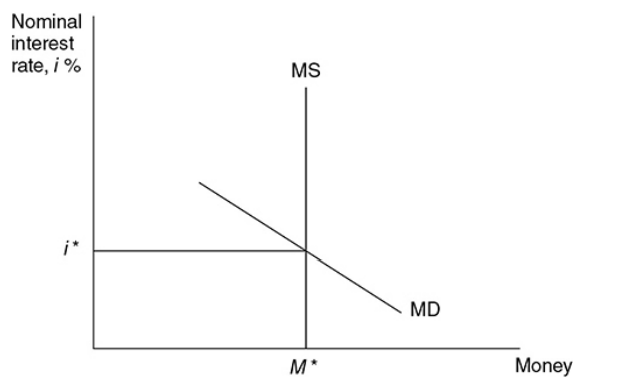
19
New cards
Price below equilibrium
Shortage occured, price must rise
20
New cards
Price above equilibrium
Surplus happened, the price must fall
21
New cards
Breadth of scope
The supply of loanable funds comes from saving whilst the supply of money includes savings, currency and checkings deposits.
\
The demand of loanable funds comes from investment demand, but the demand for money inclused the money used for investment, consumption (transaction demand), and for holding an asset (asset demand).
\
The demand of loanable funds comes from investment demand, but the demand for money inclused the money used for investment, consumption (transaction demand), and for holding an asset (asset demand).
22
New cards
Different philosophies
* Classical economists believe that for any level of GDP, the interest rate adjusts to balance the supply and demand for loanable funds, and the price level adjusts to keep the money market in equilibrium. Basically they say the price level is flexible.
* Keynesian economists believe that for any price level, the interest rate adjusts to balance the supply and demand for money, and this interest rate influences aggregate demand and the short-run level of GDP. So, the price level is sticky.
* Keynesian economists believe that for any price level, the interest rate adjusts to balance the supply and demand for money, and this interest rate influences aggregate demand and the short-run level of GDP. So, the price level is sticky.
23
New cards
Graphing
The vertical axis of th emoney market should be labeled with a nominal interest rate and the vertical axis of the loanable funds with the real interest rate.
24
New cards
Money supply increases
There’s a temporary surplus at the original equilibrium price. When there’s surplus money, people find other assets, such as bonds, to invest their money in. With more people looking for bonds, its demand raises as well as its price and the effective interest rate paid on bonds is lowered.
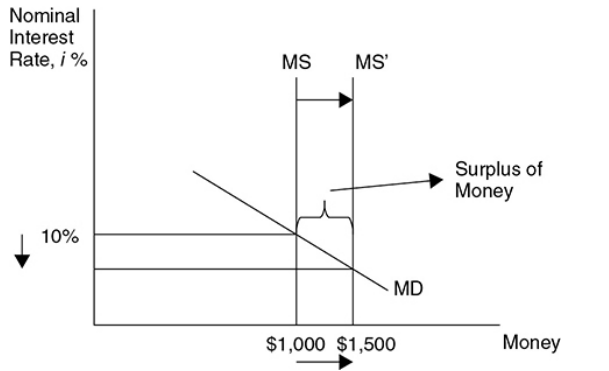
25
New cards
Supply money
The money increased by the Fed in the money supply at the original interest rate.
\
* An increase in the money supply decreases the interest rate.
\
* An increase in the money supply decreases the interest rate.
26
New cards
Decrease in the money supply
* A shortage of money sends some bondholders to sell their bonds so that they have money for transactions.
\
* An increase in the supply of bonds in the bond market decreases the price and increases the rate of interest earned on those assets.
\
Decreasing the money supply increases interest rates
\
* An increase in the supply of bonds in the bond market decreases the price and increases the rate of interest earned on those assets.
\
Decreasing the money supply increases interest rates
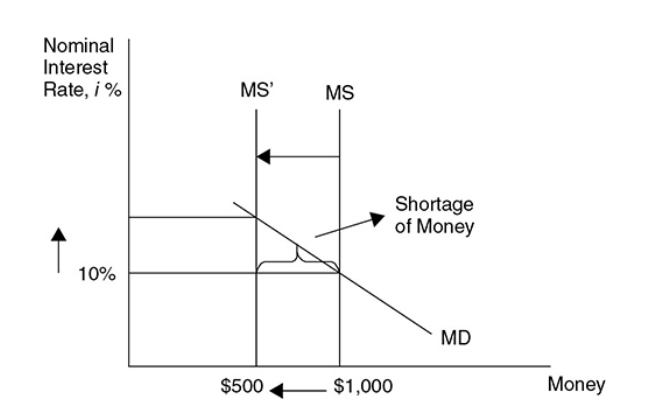
27
New cards
Fractional reserve banking
A system in which only a fraction of the total money deposited in banks is held in reserve as currency
28
New cards
Reserve ratio (rr)
The fraction of a banks total deposits that are kept on reserve.
* Reserve ratio (rr) = Cash reserves/Total deposits.
* Reserve ratio (rr) = Cash reserves/Total deposits.
29
New cards
Reserve requirement
Regulation set by the Fed that states the minimum reserve ratio for banks
30
New cards
Excess reserves
The cash reserves held by banks above and beyond the minimum reserve requirement
31
New cards
T-account or balance sheet
A tabular way to show the assets and liabilities of a bank. Total assets must equal liabilities.
32
New cards
Asset of a bank
Anything owned by the bank or owed to the bank is an asset of the bank
33
New cards
Liability of a bank
Anything owned by depositors or lenders is a liability to the bank
34
New cards
Money multiplier
This measures the maximum amount of new checking deposits that can be created by a single dollar of excess reserves.
\
M = 1/(reserve ratio) = 1/rr.
\
M = 1/(reserve ratio) = 1/rr.
35
New cards
Money multiplier is smaller if
* At any stage the banks keep more than the required dollars in reserve
* At any stage borrowers do not redeposit funds into the bank and keep some as cash
* Customers are not willing to borrow.
* At any stage borrowers do not redeposit funds into the bank and keep some as cash
* Customers are not willing to borrow.
36
New cards
Three general tools of monetary policy managed by the Federal Reserve
* Engaging in open market operations
* Changing the discount rate
* Changing the required reserve ratio
* Changing the discount rate
* Changing the required reserve ratio
37
New cards
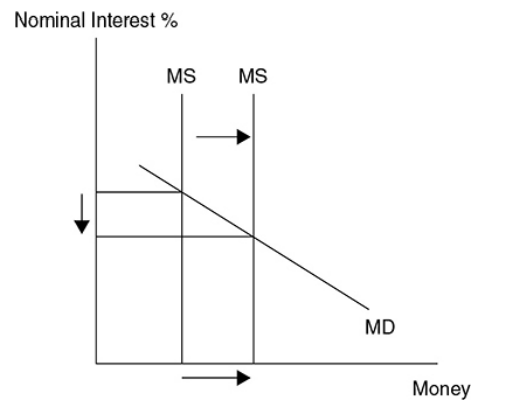
Expansionary monetary policy
Designed to fix a recession by lowering interest rates to increase aggregate demand, lower the unemployment rate, and increase real GDP, which may increase the price level
\
* By increasing the money supply, the interest rate gets lower. Lower interest increases private consumption and investments, which shifts the **AD curve to the right.**
\
* By increasing the money supply, the interest rate gets lower. Lower interest increases private consumption and investments, which shifts the **AD curve to the right.**
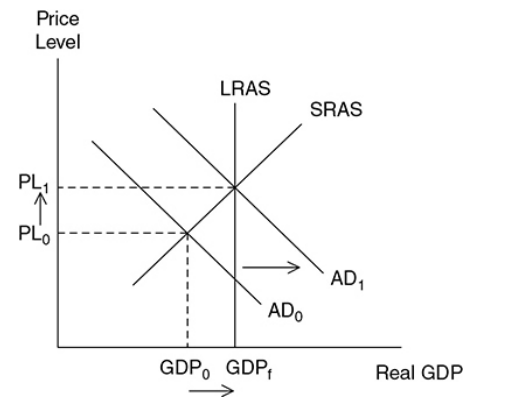
38
New cards
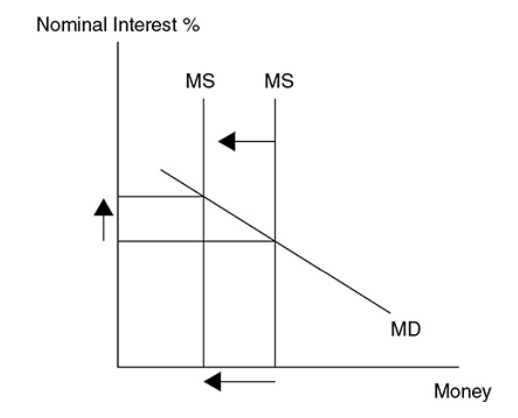
Contractionary monetary policy
Designed to avoid inflation by increasing interest rates to decrease aggregate demand, which lowers the price level and decreases real GDP back to full employment
\
* When the money supply is decreased, the interest rate increases causing a decrease in private consumption and investment **shifting AD to the left**.
\
* When the money supply is decreased, the interest rate increases causing a decrease in private consumption and investment **shifting AD to the left**.
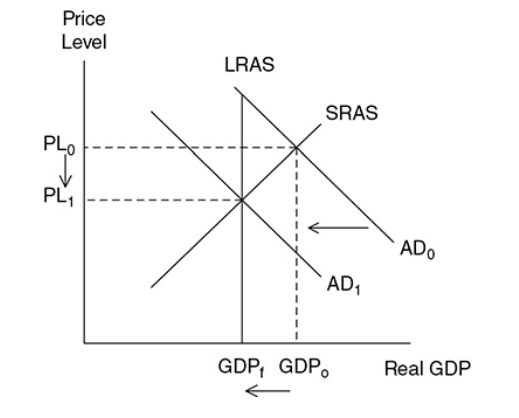
39
New cards
Open market operations (OMOs)
A traditional tool of monetary policy, it involves the Feds buying (or selling) of securities from (or to) commercial banks and the general public
40
New cards
When Fed buys
* **BB = BB** → **B**uying **B**onds = **B**igger **B**ucks.
41
New cards
When Fed sells
* **SB = SB** → **S**elling **B**onds = **S**maller **B**ucks.
42
New cards
Federal funds rate
The interest rate paid on short-term loans made from one bank to another
43
New cards
FOMC wants to lower interest rates
It buys bonds
44
New cards
FOMC wants to rise interest rates
Sells bonds
45
New cards
Discount rate
The interest rate commercial banks pay on short-term loans from the Fed
46
New cards
Lowering the discount rate
Increases excess reserves in banks and expands the money supply.
47
New cards
Raising the discount rate
Decreases excess reserves in commercial banks and contracts the money supply.
48
New cards
Lowering the reserve ratio
Increases excess reserves in commercial banks and expands the money supply.
49
New cards
Increasing the reserve ratio
Decreases excess reserves in commercial banks and contracts the money supply.
50
New cards
Ample reserves regime
The current framework for the Federal Reserves monetary policy
51
New cards
They make changes to two administered interest rates
IOR and ON RRP
52
New cards
Interest on reserves (IOR)
The interest rate that is paid to banks that deposit excess reserves with the Fed. **Primary tool of current monetary policy.** The federal fund rates rise and fall along with the IOR.
53
New cards
Arbitrage
"Borrow low and save high" technique
54
New cards
Overnight reverse repurchase agreement (ON RRP)
This is a secondary tool of current monetary policy. The interest rate paid to a financial institution on an overnight transaction in which the Federal Reserve sells a U.S. government security to the financial institution while agreeing to buy the security back the next day.
\
Created to avoid arbitrage
\
Created to avoid arbitrage
55
New cards
In a deep recessionary gap
Expansionary monetary policy could be used to assist expansionary fiscal policy to quickly move to full employment. The risk then becomes a **burst of inflation**.
56
New cards
In a mild recessionary gap
Contractionary monetary policy could be used to offset expansionary fiscal policy to gradually move to full employment. The risk then becomes **rising interest rates**.
57
New cards
In an **inflationary gap**
Contractionary monetary policy could be used to assist contractionary fiscal policy to put downward pressure on the price level. The risk then becomes a **rising unemployment rate.**
58
New cards
Monetarists
They argue against active open market purchases of Treasury securities on the grounds that such expansions of the money supply will not create more economic growth in the long run and will only create inflation.
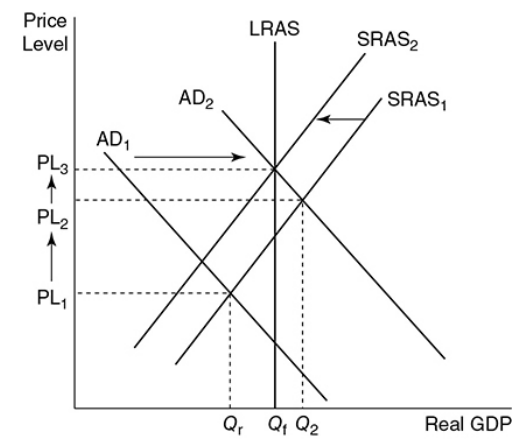
59
New cards
Critical link between monetary policy and real GDP
The relationship between changes in money supply, the real interest rate, and the level of private investment.
60
New cards
Quantity theory of money
A theory that asserts that the quantity of money determines the price level and that the growth rate of money determines the rate of inflation.
\
It predicts that any increase in the money supply only causes an increase in the price level.
\
It predicts that any increase in the money supply only causes an increase in the price level.
61
New cards
Equation of exchange
A way to view the quantity theory of money
\
The equation says that nominal GDP (P × Q) is equal to the quantity of money (M) multiplied by the number of times each dollar is spent in a year (V). **MV = PQ.**
\
The equation says that nominal GDP (P × Q) is equal to the quantity of money (M) multiplied by the number of times each dollar is spent in a year (V). **MV = PQ.**
62
New cards
Velocity of money
The average number of times that a dollar is spent in a year
**V = PQ/M.**
**V = PQ/M.**
63
New cards
To accommodate an increase in the money supply
The velocity of money **must fall**, the price level **must rise**, or the economy’s output of goods and services **must increase**.